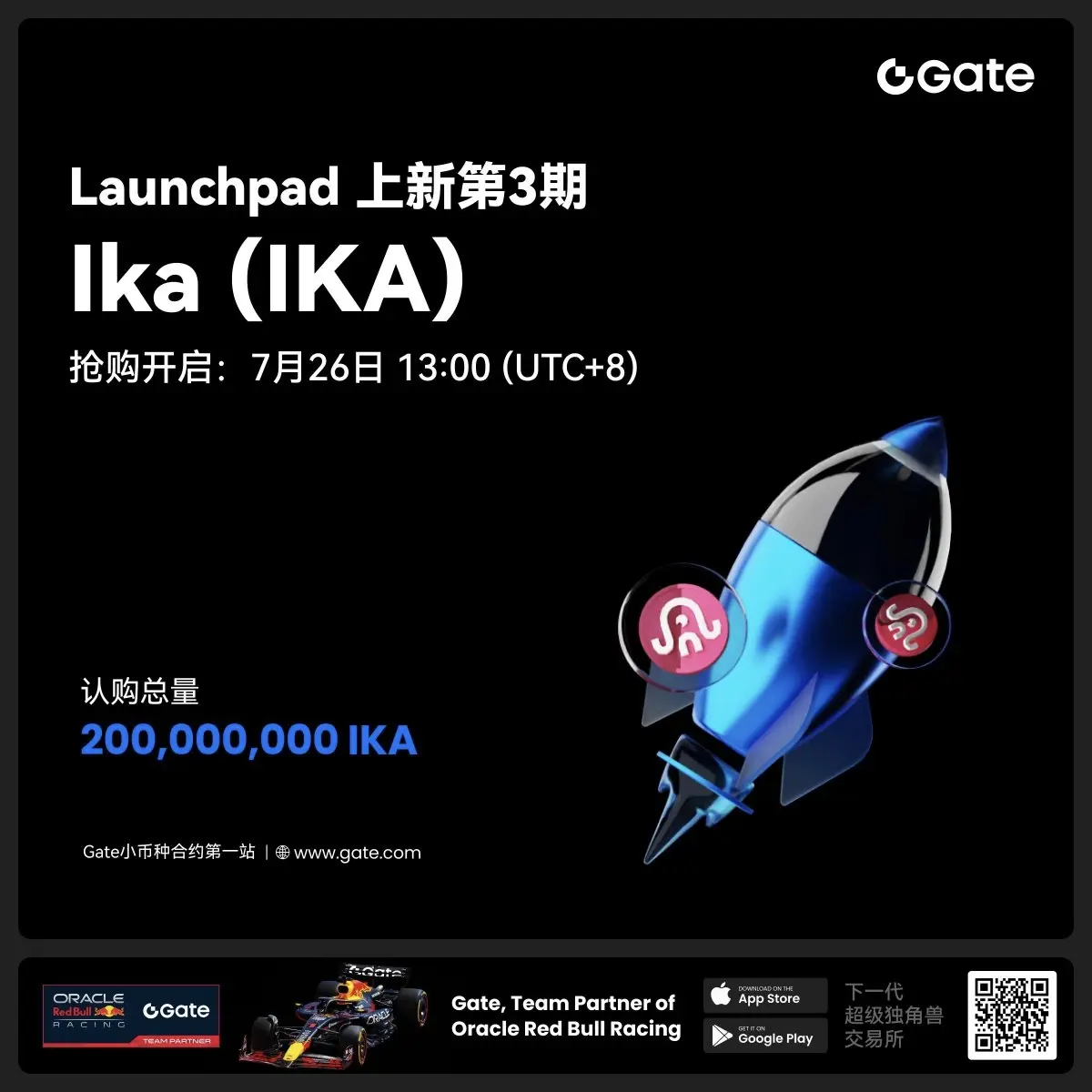- 話題1/3
49k 熱度
3k 熱度
2k 熱度
282 熱度
413 熱度
- 置頂
- 🎉 Gate 廣場 IKA Launchpad 發帖活動來襲!🎉
Gate Launchpad 認購 IKA 最後24小時!曬出你的認購體驗,和大家一起分享,每個人都有機會瓜分 $200 獎池!
🎁 4位幸運分享者*$50合約體驗券每人!
🧐 如何參與:
1.在廣場發帖,帶上 #GateLaunchpad上线IKA# 標籤
2.曬出你的認購截圖 或 分享你的獨特認購小竅門/心得或趣事
3.保證帖子大於50字,內容有趣有料,原創,集齊至少3個互動(點讚/評論/轉發)
IKA認購連結:https://www.gate.com/launchpad/2336?downgarde=true
活動時間:7月28日 12:00 - 7月30日 24:00 (UTC+8)
趕快加入,分享你的精彩時刻,你就是下一個幸運兒!
- 📢 Gate廣場 #创作者活动第二期# 正式開啓!
聚焦 ZKWASM 系列活動,分享你的觀點,瓜分 4,000 枚 $ZKWASM!
ZKWASM 作爲 zk 公鏈先鋒,正在 Gate 平台重磅推廣!
三大活動聯動上線:Launchpool 認購、CandyDrop 空投、Alpha 專屬交易——不要錯過!
🎨 活動一:發布廣場貼文,贏內容獎勵
📅 時間:7月25日 22:00 - 7月29日 22:00(UTC+8)
📌 參與方式:
- 在 Gate 廣場發布與 ZKWASM 或其三大活動相關的原創內容(不少於 100 字)
- 添加標籤: #创作者活动第二期# #ZKWASM#
- 附本人參與 Launchpool/CandyDrop/Alpha 的截圖(如認購、空投或交易)
🏆 獎勵設置:
- 一等獎(1名):1000 枚 $ZKWASM
- 二等獎(2名):500 枚 $ZKWASM
- 三等獎(10名):100 枚 $ZKWASM
📋 評選標準:內容質量、互動量、項目相關性,附活動參與截圖者優先。
📢 活動二:發推贏傳播力獎勵
📌 參與方式:
- 在 X(推特)發布與 ZKWASM 或三大活動相關的原創內容(不少於 100 字)
- 添加標籤: #ZKWASM # GateSquare
- 填寫登記表 👉 https://www.gate.com/quest
- 📢 Gate廣場 #MBG任务挑战# 發帖贏大獎活動火熱開啓!
想要瓜分1,000枚MBG?現在就來參與,展示你的洞察與實操,成爲MBG推廣達人!
💰️ 本期將評選出20位優質發帖用戶,每人可輕鬆獲得50枚MBG!
如何參與:
1️⃣ 調研MBG項目
對MBG的基本面、社區治理、發展目標、代幣經濟模型等方面進行研究,分享你對項目的深度研究。
2️⃣ 參與並分享真實體驗
參與MBG相關活動(包括CandyDrop、Launchpool或現貨交易),並曬出你的參與截圖、收益圖或實用教程。可以是收益展示、簡明易懂的新手攻略、小竅門,也可以是現貨行情點位分析,內容詳實優先。
3️⃣ 鼓勵帶新互動
如果你的帖子吸引到他人參與活動,或者有好友評論“已參與/已交易”,將大幅提升你的獲獎概率!
MBG熱門活動(帖文需附下列活動連結):
Gate第287期Launchpool:MBG — 質押ETH、MBG即可免費瓜分112,500 MBG,每小時領取獎勵!參與攻略見公告:https://www.gate.com/announcements/article/46230
Gate CandyDrop第55期:CandyDrop x MBG — 通過首次交易、交易MBG、邀請好友註冊交易即可分187,500 MBG!參與攻略見公告:https://www.gate.com/announcements
- 📢 #Gate广场征文活动第三期# 正式啓動!
🎮 本期聚焦:Yooldo Games (ESPORTS)
✍️ 分享獨特見解 + 參與互動推廣,若同步參與 Gate 第 286 期 Launchpool、CandyDrop 或 Alpha 活動,即可獲得任意獎勵資格!
💡 內容創作 + 空投參與 = 雙重加分,大獎候選人就是你!
💰總獎池:4,464 枚 $ESPORTS
🏆 一等獎(1名):964 枚
🥈 二等獎(5名):每人 400 枚
🥉 三等獎(10名):每人 150 枚
🚀 參與方式:
在 Gate廣場發布不少於 300 字的原創文章
添加標籤: #Gate广场征文活动第三期#
每篇文章需 ≥3 個互動(點讚 / 評論 / 轉發)
發布參與 Launchpool / CandyDrop / Alpha 任一活動的截圖,作爲獲獎資格憑證
同步轉發至 X(推特)可增加獲獎概率,標籤:#GateSquare 👉 https://www.gate.com/questionnaire/6907
🎯 雙倍獎勵機會:參與第 286 期 Launchpool!
質押 BTC 或 ESPORTS,瓜分 803,571 枚 $ESPORTS,每小時發放
時間:7 月 21 日 20:00 – 7 月 25 日 20:00(UTC+8)
🧠 寫作方向建議:
Yooldo
- 🎉Gate 2025 上半年社區盛典:內容達人評選投票火熱進行中 🎉
🏆 誰將成爲前十位 #Gate广场# 內容達人?
投票現已開啓,選出你的心頭好
🎁贏取 iPhone 16 Pro Max、限量週邊等好禮!
📅投票截止:8 月 15 日 10:00(UTC+8)
立即投票: https://www.gate.com/activities/community-vote
活動詳情: https://www.gate.com/announcements/article/45974
Web3邁向合規!我們努力搞的加密普及之路,是不是走錯路了?
最近產業內關於以太坊 Fud 的事情大家討論的沸沸揚揚,前段時間劍哥、Haotian 老師和 NingNing 老師發起了一場長達三小時關於《以太坊到底怎麼了》的 Space 討論,菠菜全場參與,聽到了許多非常精彩的觀點,從以太坊和 Layer 2 之間的博弈關係,到意識形態、組織結構、歷史教訓的角度全面學習瞭解了目前以太坊和產業面臨的困境,感受到了大家對於以太坊「愛之深,責之切」的心情。
在 Space 期間,其實我內心已經醞釀了一些想法,但是又十分猶豫,因為知道自己的觀點與大多數人 Web3 Native 的觀點有明顯分歧,怕被噴(深知產業氛圍烏煙瘴氣),所以全程並沒有發表言論,但是事後還是決定站出來發表自己的觀點,嘗試從大家老生常談的應用層面為大家提供一個觀察當下以太坊乃至整個產業所面臨挑戰的新視角。儘管這種觀點可能不夠主流,但我相信,只有通過理性且坦誠的討論,才能推動產業向著更健康的方向發展。
本文並非 FUD 以太坊和產業,不想挑起任何對立,僅僅是提供一個不同的視角供大家批判和思考,如果你不認同我的觀點,一笑便是,勿噴,謝謝!文章較長,菠菜整理了一個 AI 總結給不想讀長文的小夥伴。
圖源:PANews
背景
在講觀點之前,先介紹一下菠菜目前的工作背景,許多關注菠菜的小夥伴應該也有注意到,過去很長一段時間菠菜的輸出頻率降低了許多,對於產業也很少發表觀點了。
這是因為過去一年的時間裡,菠菜作為新加坡新創 FinTech 公司 Ample FinTech 的創始成員,深度參與了與三個國家央行關於通證化、跨境支付的項目合作中,這段經歷也讓我的思維模式和注意力不再局限於純 Web3 圈子,而是將目光投向了全球央行以及傳統金融機構的戰略動向。
期間菠菜開始花費大量時間去研究來自於傳統勢力發表的區塊鏈和通證化相關的研報和論文,瞭解他們正在做的項目,同時也保持推特上關注產業動向以及與朋友交流瞭解 Web3 產業的發展動向,通過同時關注 Web3 圈子和傳統金融體系的應用發展脈絡,我得以在兩個維度之間建立起更全面的認知架構,這也讓我對產業未來的理解有了不同的視角。
割裂的平行世界
正是這種同時處於兩個不同世界的雙重視角,讓我越發明顯地感知到兩個產業的氛圍和發展路徑的割裂。在 Web3 世界裡,大家都在吐槽的現狀是:越來越多的技術基礎設施在出現,越來越多的新概念、新術語層出不窮,刻意製造複雜性並提高了理解門檻,最終目的大多數都是面向 Vitalik 和交易所創業,在 TGE 之後就幾乎淪為「鬼城」,至於有沒有真實使用價值,又有誰真的在乎呢?
而近期大家的討論焦點也轉向了對 Vitalik 和以太坊基金會的質疑。越來越多的聲音在抱怨:Vitalik 與基金會似乎過於沈迷於「技術論道」和「理想追求」,投入大量精力鑽研技術細節,卻對使用者的實際需求和商業化探索顯得興致寥寥。這種傾向引發了產業內的普遍擔憂。
而在這場 Space 中,孟岩老師 @myanTokenGeek 借鑒網路發展的歷史經驗,一針見血地指出:這種脫 C、疏離市場的發展路徑是難以持續的。如果以太坊繼續保持這種「技術至上」的發展取向,那麼大家的這種擔憂不無道理。
然而,當我們將視野投向 Crypto 圈外,卻發現了截然不同的景象:傳統金融勢力與各國政府對 Web3 技術的態度正在發生顯著轉變。他們不僅將區塊鏈和通證化視為現有支付與金融體系的重要升級契機,更積極主動地探索轉型之路。這種轉變固然源於對新技術的認可,但更深層的動因或許是感受到了 Web3 技術對既有格局帶來的衝擊與威脅。
而在 2024 年,一個具有里程碑意義的轉折出現了,被譽為「央行的央行」的國際清算銀行(BIS)正式提出了「Finternet」(金融網路)的概念。
這一舉措意義深遠——它將通證化和區塊鏈技術定位為人類金融貨幣體系的下一代範式,瞬間在傳統金融界引發軒然大波,成為最受關注的話題之一。
這不僅僅是一個新概念的提出,更是傳統金融界對區塊鏈和通證化技術的一次重要背書。其影響迅速擴散:全球各大金融機構和各國央行紛紛加快步伐,在通證化基礎設施建設、資產數位化以及支付應用落地等方面展開了前所未有的積極探索。
在這一系列重大舉措的背後,絕非國際清算銀行一時興起的倉促決定,而是基於多年深入研究後的戰略抉擇。菠菜花了大量時間追溯和研究國際清算銀行的決策軌跡,發現了一個循序漸進的發展脈絡:早在 2018 年,該機構就開始系統性地研究 Web3 技術,並陸續發表了數十篇極具專業深度的研究論文。
2019 年,國際清算銀行更是邁出了關鍵性的一步——成立國際清算銀行創新中心,系統性地展開區塊鏈和通證化相關的實驗項目。這一系列深入的研究和實踐,最終讓他們認識到了一個重要事實:區塊鏈技術和通證化革新背後,蘊含著足以重塑全球金融格局的巨大潛力。
在國際清算銀行的諸多實驗項目中,最具標誌性的當屬 mBridge——這個由其國際清算銀行香港創新中心聯合中國央行、香港金管局、泰金央行和阿聯酋央行於 2019 年共同發起的 CBDC 跨境支付橋。從技術架構來看,mBridge 本質上是一個基於 EVM 的公共許可鏈,由各參與國央行作為節點營運,支持各國央行數位貨幣(CBDC)在鏈上直接進行跨境結算。
然而,歷史總是充滿戲劇性的轉折。在目前複雜的地緣政治格局下,特別是俄烏衝突爆發後,這個最初旨在提升跨境支付效率的項目,意外成為了金磚國家規避 SWIFT 國際制裁的重要工具。
這一局面的出現迫使國際清算銀行在此階段選擇退出 mBridge 項目。而近期,俄羅斯更是以此為基礎,正式推出了基於區塊鏈技術的 BRICS Pay 國際支付結算系統,將區塊鏈技術推向了地緣政治博弈的前沿。
國際清算銀行的另一項重大舉措是啟動了區塊鏈史上規模最為宏大的公私合作項目—— Project Agora。這個項目匯聚了空前的參與陣容:七大主要央行(聯準會、代表歐盟的法國央行、日本央行、韓國央行、墨西哥央行、瑞士央行、英格蘭央行),以及包括 SWIFT、 VISA、 MasterCard、匯豐銀行在內的 40 多家全球金融巨頭。
如此大規模的跨國協作,其目標出奇地明確:利用區塊鏈技術和智能合約,在維護現有金融秩序的前提下,構建一個全球統一的帳本體系,從而優化現有的金融貨幣體系。這一舉措本身就是一個強有力的信號:區塊鏈技術的發展勢頭已不可阻擋,傳統金融勢力已經從觀望轉向全面擁抱,並積極推動其在實際場景中的應用。
而反觀 Web3 產業,雖然天天高喊著 Mass Adoption 的口號,實際卻熱衷於炒作迷因幣,沈醉於短期的注意力經濟。這種鮮明的對比,不禁讓人深思:當傳統金融機構正在以實際行動推動區塊鏈技術的規模化應用時, Web3 產業是否也應該重新思考自己的發展方向?
大規模採用:賭場還是應用程式?
在這種割裂的發展態勢下,我們不得不思考一個根本性的問題:「什麼才是真正意義的 Mass Adoption?」雖然這個詞頻繁出現在 Web3 產業的討論中,但似乎每個人對它的理解都存在顯著差異。
回顧過去幾年 Web3 產業所謂的「爆款項目」,一個耐人尋味的規律浮現出來:那些號稱實現「 Mass Adoption」的項目,本質上都是披著創新外衣的投機遊戲。無論是層出不窮的迷因幣,還是打著 GameFi 旗號的「 P2E」模式(比如風靡一時的跑鞋項目),又或是標榜社交創新的 SocialFi(如 http:// Friend.tech),細究其本質,都不過是經過精心包裝的「數位賭場」。這些項目雖然在短期內吸引了大量使用者湧入,但它們並非在真正解決使用者的實際需求和痛點。
如果說讓越來越多的人進來參與投機炒作,拉高幣價是 Mass Adoption 的話,那麼這種「 Adoption」僅僅只是一場財富向少數人集中的零和遊戲,其不可持續性是顯而易見的。
菠菜親眼目睹了太多圈外朋友踏入幣圈後血本無歸的案例,能夠真正獲利的鳳毛麟角。這一現象也在最近的數據中得到了印證:近期一位鏈上數據分析師的研究顯示,在 http:// pump.fun 平台上,僅有 3% 的使用者獲利超過 1,000 美元,而這冰冷的數位背後,折射出炒幣獲利實為極少數人的遊戲。
更令人憂慮的是,整個產業儼然成為了駭客、釣魚和詐騙的溫床,時不時的就能在推特上看見某巨鯨被 Permit 釣魚損失慘重的資訊。更別說普通散戶了,根據 FBI 最新報告,僅 2023 年,美國民眾就在加密貨幣產業蒙受了超過 56 億美元的詐騙損失,並且 60 歲以上年齡的受害者居然佔總人數的 50%,許多普通投資人的利益在這個「黑暗森林」根本無法得到保障。
而投機和越來越嚴重的駭客行為使得產業環境日益惡化,這不禁讓我們深思:我們是否在追逐一個錯誤的「 Mass Adoption」方向?在狂熱的投機氛圍中,我們是否忽視了真正可持續的價值創造?
需要明確的是,我並非要全盤否定 Web3 的投機屬性。畢竟,絕大多數參與者進入這個產業的初衷都是為了獲得投資報酬率,這種逐利動機本身無可厚非,投機屬性也將持續存在。然而, Web3 不應該,也不能僅僅止步於做一個全球大賭場。它需要發展出真正具有可持續性和實際價值的應用場景。
而其中支付和金融無疑是 Web3 技術最具落地潛力的應用產業。這一點已經得到了來自傳統金融勢力、國家政府和市場層面的共識:我們看到傳統金融勢力正在大規模探索各類創新應用,包括支付系統革新、現實世界資產通證化( RWA)、 DeFi 與傳統金融的融合,以及新興的 PayFi 概念。這些積極的探索和實踐,清晰地指向了目前市場最迫切的需求所在。
菠菜個人愚見,對於以太坊或者產業來說,核心問題可能不在於技術方向是否正確,而在於我們是否真正理解了什麼是有價值的應用。當我們過分關注技術革新,卻忽視了市場需求;當我們熱衷於製造概念,卻遠離了真實場景,這樣的發展方向真的是正確的嗎?
這種思考引發了一個更深層的憂慮:如果繼續這樣發展下去,會不會我們曾經立志要顛覆的傳統金融體系或 SWIFT 網路,反而成為推動區塊鏈真正大規模採用的主力軍?更進一步說,是否會出現這樣的局面:傳統金融勢力和政府主導的公共許可區塊鏈系統主導了絕大多數實際應用場景,而公鏈則可能被邊緣化為小眾的「投機樂園」?
當 Web3 產業的目光仍聚焦在 Solana 等以太坊「挑戰者」身上時,似乎沒有人把目光關注到傳統金融勢力也已經吹響了進軍號角。面對這場巨變,是否對於以太坊或者整個產業來說,我們要思考的不僅是目前的發展策略,還有如何未來產業逐漸合規化的浪潮中找准自己的定位和價值主張?這或許才是產業面臨的真正考驗。
在觀察到這些趨勢後,我對產業真正健康、可持續的 Mass Adoption 之路有了以下思考:
首要的是解決實際問題:
無論基礎設施還是應用,我們都應該立足於現實需求,著力解決真實痛點,例如全球仍有許多老百姓、中小微企業都難以訪問金融服務;例如企業使用區塊鏈的隱私問題等等。技術創新的價值,終究要通過解決實際問題來體現。
其次是降低使用門檻:
技術的終極目標是服務使用者,而非製造障礙。目前 Web3 世界中層出不窮的術語和複雜概念,某種程度上反而阻礙了真正的普及。我們需要讓技術變得更加平易近人,例如利用( Based Chain Abstraction)鏈抽象技術來解決使用者體驗層面的問題。
第三是創造持續價值:
產業的良好發展必須建立在可持續的商業模式之上,而不能過度依賴投機炒作。只有真正創造價值的項目,才能在市場的考驗中長期存活,例如 Web3 支付、 PayFi 和 RWA 等等。
技術創新的重要性毋庸置疑,但我們也要認識到:應用才是第一生產力。沒有實際應用作為基礎,再多的基礎設施、再先進的技術,終究只是空中樓閣。
Web3 應用 Mass Adoption 拐點已來
縱觀歷史,區塊鏈與現實世界的結合嘗試從未間斷,但往往因時機未到、監管限制或技術瓶頸等多重因素而未能真正落地。然而,當下的形勢卻呈現出前所未有的轉機:技術基礎設施日趨成熟,傳統金融勢力開始積極擁抱創新並探索實際應用,同時,全球各國的監管架構也在逐步完善。這些跡象都在預示著,未來幾年很可能成為 Web3 應用邁向大規模採納的關鍵轉折點。
在這個重要節點上,監管合規既是最大的挑戰,也是最具潛力的機遇。越來越多的信號表明,Web3 產業正在從最初的「蠻荒時代」逐漸邁入一個「合規新紀元」。這個轉變不僅意味著更規範的市場環境,更預示著真正可持續發展的開端。
這種轉變的信號體現在多個層面:
香港推出全面的虛擬資產服務提供商(VASP)監管制度
歐盟 MiCA 法案的正式實施
美國 FIT21 法案 2024 年在眾議院通過
日本修訂《資金決濟法》,為加密資產提供明確定義
貝萊德等大型資管機構推出比特幣、以太坊 ETF
傳統銀行開始為加密企業提供託管服務並推出通證化銀行存款
主流支付公司推出合規穩定幣
投資銀行設立數位資產交易部門
更多交易所主動申請合規牌照
KYC/AML 解決方案的廣泛應用
合規性穩定幣的崛起
隱私計算技術在合規場景中的應用
央行級區塊鏈的推出(CBDC 貨幣橋 mBridge、新加坡 Global Layer 1、國際清算銀行 Project Agora 等)
最大去中心化穩定幣項目 MakerDAO 轉型 Sky 擁抱合規
FBI 釣魚執法迷因項目造市商
DeFi 項目紛紛開始引入 KYC/AML 機制
在這種趨勢下,我們正在看到:
更多傳統金融機構通過收購或合作方式進軍 Web3 產業
傳統金融勢力通過比特幣 ETF 不斷掌控比特幣的價格話語權
新一代合規化的 Web3 應用快速崛起
整個產業在監管壓力下逐步建立秩序,一夜暴富的機會將不斷減少
穩定幣的應用場景從投機轉向國際貿易等實質性用途
毫無疑問,區塊鏈技術的未來主戰場將聚焦於幾個關鍵產業:支付系統創新、實物資產通證化(RWA)、新興的 PayFi 概念,以及 DeFi 與傳統金融(CeFi)的深度融合。而這個現實帶來了一個不可回避的命題:如果產業要在真實應用層面實現突破性發展,就必須直面與監管機構和傳統金融機構的互動。這不是選擇題,而是發展的必經之路。
現實情況是,監管始終處於產業生態的頂端。這不僅是一個客觀事實,更是過去十多年加密產業發展歷程中反復驗證的鐵律。每一次重大的產業轉折,幾乎都與監管政策息息相關。
因此,我們需要認真思考幾個根本性問題:是選擇擁抱監管,尋求與現有金融體系的共生之路,還是固守「去中心化」理念,繼續在監管灰色地帶徘徊?是追求一個純粹「賭場」式的 Mass Adoption,重復過去十年投機驅動的老路,還是致力於創造真實、可持續的價值,真正實現區塊鏈技術的革新潛力?
而目前,以太坊生態面臨著一個顯著的結構性失衡:一方面是不斷堆疊的基礎設施和層出不窮的技術創新,另一方面卻是相對滯後的應用生態發展。在這種反差之下,以太坊正面臨著雙重挑戰:既要應對來自 Solana 等新銳公鏈在性能和使用者體驗方面的強勁攻勢,更要警惕傳統金融勢力正在佈局的合規公共許可鏈在實際應用市場上的蠶食。
更棘手的是,以太坊還要同時應對來自兩個方向的競爭壓力:一邊是 Solana 等公鏈憑借其性能優勢,正在迷因市場上獲取越來越多的市占率和使用者注意力;另一邊則是傳統金融機構主導的公共許可鏈,正依託其天然的合規優勢和龐大的使用者基礎,在支付、資產通證化等實際應用場景中逐步佈局,未來極可能在這些關鍵產業佔據先發優勢。
如何在這種雙重夾擊之下尋求突破,在保持技術創新的同時不失市場競爭力,這些都是以太坊在謀求破局時必須正面應對的關鍵挑戰。
以上觀點僅代表個人視角,拋磚引玉,希望能激發產業內更多建設性的思考和討論。作為產業參與者,我們都應該為推動 Web3 朝著更健康、更有價值的方向發展貢獻一份力量。
由於個人認知局限,歡迎大家展開友善討論,共同探討產業的未來發展方向,另外,我自己也炒幣,也想賺錢,土狗玩家和去中心化信徒勿噴,我的觀點只是覺得產業不應該只有投機炒作,還要有一些正向的東西。
【免責聲明】市場有風險,投資需謹慎。本文不構成投資建議,使用者應考慮本文的任何意見、觀點或結論是否符合其特定狀況。據此投資,責任自負。
本文經授權轉載自:《PANews》
原文作者:菠菜菠菜